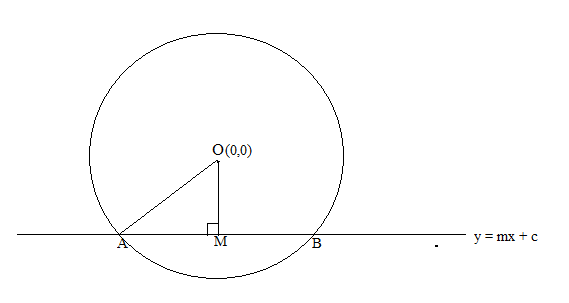
The length of intercept cut off from the line y = mx +c by the circle ${{\text{x}}^2} + {{\text{y}}^2} = {a^2}$ is
A.$\sqrt {{{\text{a}}^2}\left( {1 + {m^2}} \right) - {c^2}} $
B. $\dfrac{{\sqrt {{{\text{a}}^2}\left( {1 + {m^2}} \right) - {c^2}} }}{{\sqrt {1 + {m^2}} }}$
C. $\dfrac{{2\sqrt {{{\text{a}}^2}\left( {1 + {m^2}} \right) - {c^2}} }}{{\sqrt {1 + {m^2}} }}$
D. ${{\text{a}}^2}\left( {1 + {m^2}} \right) - {c^2}$
Answer
600.3k+ views
Hint: In this question, first we will make the diagram with the centre of the circle as (0,0) and radius as ‘a’. After this we will draw a perpendicular from centre to chord form by the given line. Then determine the length of the perpendicular and use it to calculate the length of chord.
Complete step-by-step answer:
The diagram for the question is:

OM is the perpendicular drawn from centre o. It divides AB into two parts such that AM = BM.
OA is the radius = a
We know that length of perpendicular drawn from point(${{\text{x}}_1},{{\text{y}}_1}$) is given by:
d = $\dfrac{{{\text{|a}}{{\text{x}}_1} + {\text{b}}{{\text{y}}_1} + c|}}{{\sqrt {{{\text{a}}^2} + {{\text{b}}^2}} }}$
Therefore, we can say that:
OM = $\dfrac{c}{{\sqrt {1 + {m^2}} }}$
Using Pythagoras theorem, we can write:
${\text{A}}{{\text{M}}^2} = {\text{O}}{{\text{A}}^2} - {\text{O}}{{\text{M}}^2}$
Putting the values in above equation, we get:
${\text{A}}{{\text{M}}^2} = {{\text{a}}^2} - {\left( {\dfrac{c}{{\sqrt {1 + {m^2}} }}} \right)^2}$
$ \Rightarrow $ ${\text{AM}} = \sqrt {{{\text{a}}^2} - {{\left( {\dfrac{c}{{\sqrt {1 + {m^2}} }}} \right)}^2}} = \sqrt {{{\text{a}}^2} - \dfrac{{{c^2}}}{{{{(1 + {m^2})}^{}}}}} = \sqrt {\dfrac{{{{\text{a}}^2}(1 + {m^2}) - {c^2}}}{{{{(1 + {m^2})}^{}}}}} $
Therefore, length chord AB = $2\sqrt {\dfrac{{{{\text{a}}^2}(1 + {m^2}) - {c^2}}}{{{{(1 + {m^2})}^{}}}}} $
So, option C is correct.
Note- In the question involving finding the length of the chord, you should remember the formula for finding the length of perpendicular drawn from a point(${{\text{x}}_1},{{\text{y}}_1}$) which is given by:
d = $\dfrac{{{\text{|a}}{{\text{x}}_1} + {\text{b}}{{\text{y}}_1} + c|}}{{\sqrt {{{\text{a}}^2} + {{\text{b}}^2}} }}$ . You should know that the perpendicular drawn from centre on the chord divides the chord into two equal parts.
Complete step-by-step answer:
The diagram for the question is:

OM is the perpendicular drawn from centre o. It divides AB into two parts such that AM = BM.
OA is the radius = a
We know that length of perpendicular drawn from point(${{\text{x}}_1},{{\text{y}}_1}$) is given by:
d = $\dfrac{{{\text{|a}}{{\text{x}}_1} + {\text{b}}{{\text{y}}_1} + c|}}{{\sqrt {{{\text{a}}^2} + {{\text{b}}^2}} }}$
Therefore, we can say that:
OM = $\dfrac{c}{{\sqrt {1 + {m^2}} }}$
Using Pythagoras theorem, we can write:
${\text{A}}{{\text{M}}^2} = {\text{O}}{{\text{A}}^2} - {\text{O}}{{\text{M}}^2}$
Putting the values in above equation, we get:
${\text{A}}{{\text{M}}^2} = {{\text{a}}^2} - {\left( {\dfrac{c}{{\sqrt {1 + {m^2}} }}} \right)^2}$
$ \Rightarrow $ ${\text{AM}} = \sqrt {{{\text{a}}^2} - {{\left( {\dfrac{c}{{\sqrt {1 + {m^2}} }}} \right)}^2}} = \sqrt {{{\text{a}}^2} - \dfrac{{{c^2}}}{{{{(1 + {m^2})}^{}}}}} = \sqrt {\dfrac{{{{\text{a}}^2}(1 + {m^2}) - {c^2}}}{{{{(1 + {m^2})}^{}}}}} $
Therefore, length chord AB = $2\sqrt {\dfrac{{{{\text{a}}^2}(1 + {m^2}) - {c^2}}}{{{{(1 + {m^2})}^{}}}}} $
So, option C is correct.
Note- In the question involving finding the length of the chord, you should remember the formula for finding the length of perpendicular drawn from a point(${{\text{x}}_1},{{\text{y}}_1}$) which is given by:
d = $\dfrac{{{\text{|a}}{{\text{x}}_1} + {\text{b}}{{\text{y}}_1} + c|}}{{\sqrt {{{\text{a}}^2} + {{\text{b}}^2}} }}$ . You should know that the perpendicular drawn from centre on the chord divides the chord into two equal parts.
Recently Updated Pages
a Name the selectable markers in the cloning vector class 12 biology CBSE

How are concave mirrors used in telescopes class 12 physics CBSE

Write a short note on the Perkin reaction class 12 chemistry CBSE

Differentiate between mass selection and pure line class 12 biology CBSE

Serum is aBlood without blood cells bPlasma without class 12 biology CBSE

The major product formed in the given reaction is A class 12 chemistry CBSE

Trending doubts
What are the major means of transport Explain each class 12 social science CBSE

Which are the Top 10 Largest Countries of the World?

Draw a labelled sketch of the human eye class 12 physics CBSE

Explain sex determination in humans with line diag class 12 biology CBSE

The pH of the pancreatic juice is A 64 B 86 C 120 D class 12 biology CBSE

Explain sex determination in humans with the help of class 12 biology CBSE




